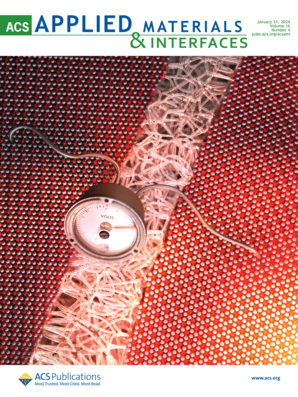Dual-Functional Ammonium Acetate as a Bilateral Buried Interface Passivator Enabling Efficient and Stable Carbon-Based Hole-Transport-Layer-Free Perovskite Solar Cells.
IF 8.3
2区 材料科学
Q1 MATERIALS SCIENCE, MULTIDISCIPLINARY
引用次数: 0
Abstract
Planar hole-transport-layer (HTL)-free carbon-based perovskite solar cells (C-PSCs) exhibit notable advantages such as low cost and improved environmental compatibility. However, their practical applications are hindered by a relatively low efficiency and poor stability. The establishment of a buried interface architecture can effectively enhance the long-term stability of the C-PSC devices. Nevertheless, defect generation during perovskite formation and associated nonradiative carrier recombination remain challenges. Herein, we introduce a bidirectional coordination strategy utilizing ammonium acetate (CH3COONH4) to passivate the tin dioxide (SnO2) surface. The CH3COONH4 treatment facilitates SnO2 oxygen vacancy passivation via interactions between CH3COO- groups and Sn4+ cations. Simultaneously, perovskite defects are effectively mitigated by the combination of CH3COO- with uncoordinated Pb2+ and the formation of N-H···I- hydrogen bonds. These interactions provide a promising foundation for perovskite crystal growth and promote vertical crystallization. Additionally, a favorable buried interface between the perovskite and underlying SnO2 layer effectively minimizes nonradiative recombination losses. Benefiting from these merits, C-PSC devices with CH3COONH4-passivated SnO2 achieved a maximum PCE of 15.5% and demonstrated exceptional operational stability, exceeding 1000 h under ambient conditions. This synergistic bidirectional coordination strategy provides an effective route for fabricating efficient and durable C-PSC devices.双功能醋酸铵作为双侧埋藏界面钝化剂实现高效稳定的碳基空穴-无传输层钙钛矿太阳能电池。
平面无空穴传输层(HTL)碳基钙钛矿太阳能电池(C-PSCs)具有成本低、环境相容性好等显著优势。然而,它们的效率相对较低,稳定性差,阻碍了它们的实际应用。建立埋藏式接口架构可以有效增强C-PSC器件的长期稳定性。然而,钙钛矿形成过程中的缺陷产生和相关的非辐射载流子重组仍然是一个挑战。本文介绍了一种利用醋酸铵(CH3COONH4)钝化二氧化锡(SnO2)表面的双向配位策略。CH3COONH4处理通过CH3COO-基团和Sn4+阳离子的相互作用促进SnO2氧空位钝化。同时,CH3COO-与不配位Pb2+结合,形成N-H···I-氢键,有效地减轻了钙钛矿的缺陷。这些相互作用为钙钛矿晶体生长和促进垂直结晶提供了良好的基础。此外,钙钛矿和SnO2层之间有利的埋藏界面有效地减少了非辐射复合损失。得益于这些优点,ch3coonh4钝化SnO2的C-PSC器件实现了15.5%的最大PCE,并表现出卓越的工作稳定性,在环境条件下超过1000小时。这种双向协同策略为制造高效耐用的C-PSC器件提供了有效途径。
本文章由计算机程序翻译,如有差异,请以英文原文为准。
求助全文
约1分钟内获得全文
求助全文
来源期刊

ACS Applied Materials & Interfaces
工程技术-材料科学:综合
CiteScore
16.00
自引率
6.30%
发文量
4978
审稿时长
1.8 months
期刊介绍:
ACS Applied Materials & Interfaces is a leading interdisciplinary journal that brings together chemists, engineers, physicists, and biologists to explore the development and utilization of newly-discovered materials and interfacial processes for specific applications. Our journal has experienced remarkable growth since its establishment in 2009, both in terms of the number of articles published and the impact of the research showcased. We are proud to foster a truly global community, with the majority of published articles originating from outside the United States, reflecting the rapid growth of applied research worldwide.
 求助内容:
求助内容: 应助结果提醒方式:
应助结果提醒方式:


